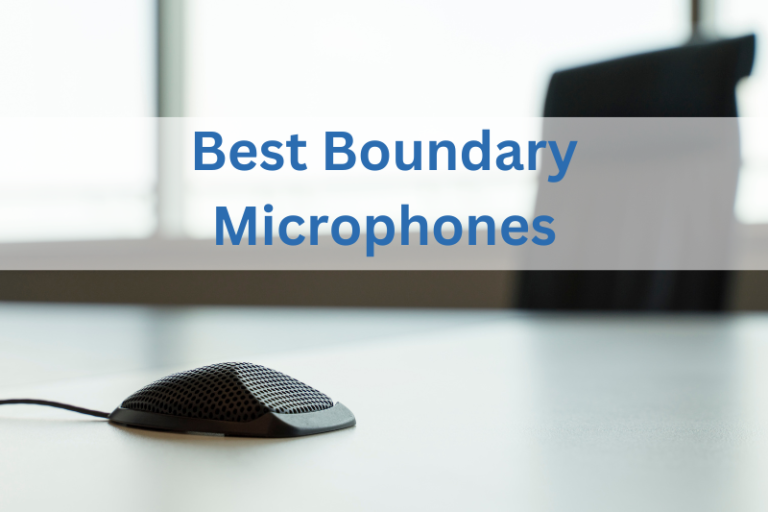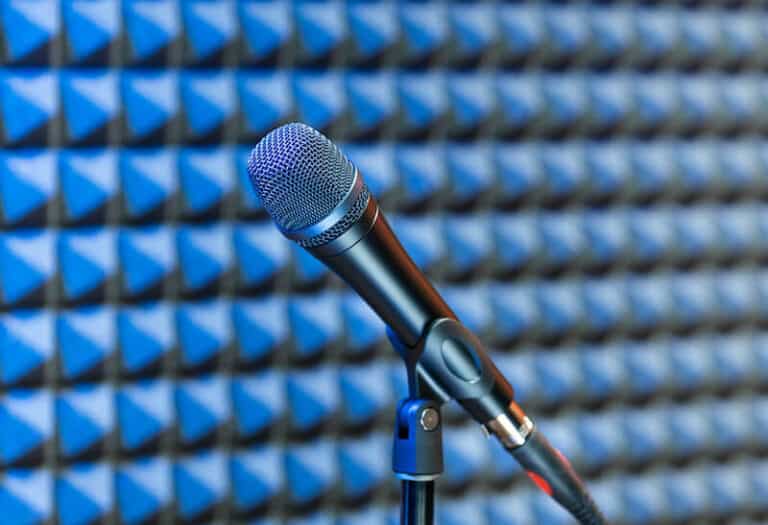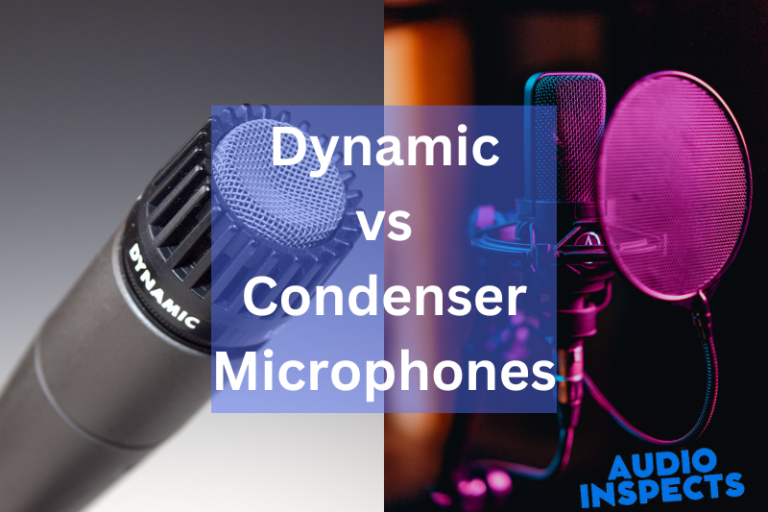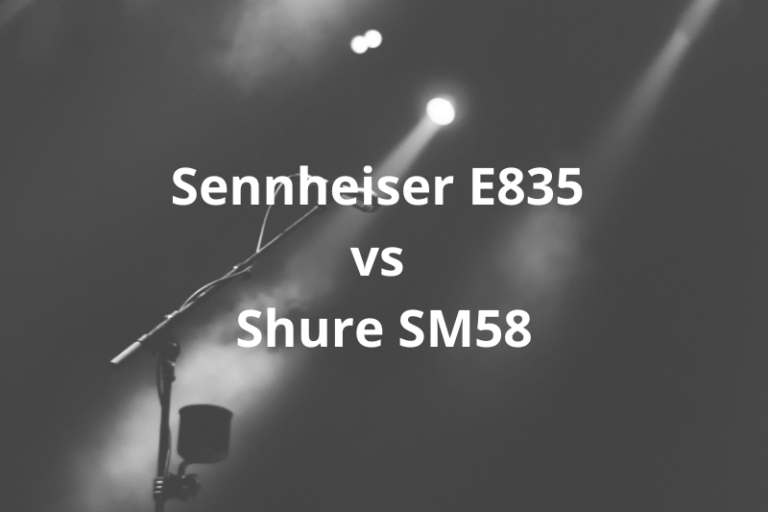Sennheiser E835 vs Shure SM58: Which one should you choose?
In this detailed comparison, we compare two popular cardioid mics and try to answer which one wins the Sennheiser E835 vs Shure SM58 battle.
The Shure SM58 is a popular wireless microphone that is widely used in live music, sports, and radio broadcasting. It is the most sought-after microphone among professionals who work in various fields, such as music, film, television, radio, and sports.
However, the Shure SM58 has a shortcoming of being susceptible to wind noise when placed on a moving vehicle, such as a car, motorcycle, bicycle, or boat. The Sennheiser E835 is a wireless microphone that has low wind noise. In fact, the Sennheiser E835 has been used by various professional musicians, athletes, and radio broadcasters.
It is also known as the Sennheiser E835 is a two-channel hand-held wireless microphone for professional use. It is lightweight and portable. The Sennheiser E835 is designed with high-quality sound quality, and the wireless mic delivers crisp and clear sound.
You can choose between the Shure SM58 and the Sennheiser E835, and here are some pros and cons of each product to help you make a better decision.
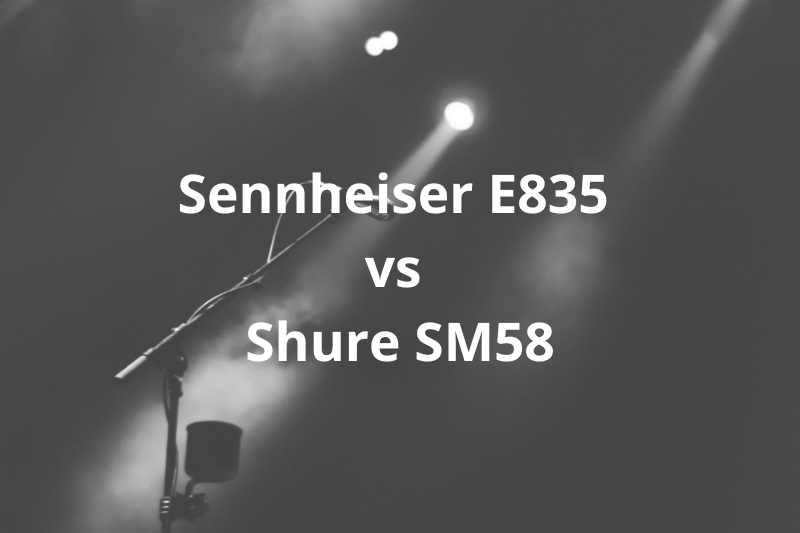
Sennheiser E835 vs Shure SM58
The Sennheiser e835 and Shure SM58 are two of the most popular microphone models among vocalists, audio engineers, and music producers alike. Both mics offer excellent sound quality and reliable performance. However, there are some key differences between the two that should be considered when selecting a mic for your needs.
Design and build
In this section, we are going to compare and contrast the Sennheiser E835 and the Shure SM58 look and feel.
The Shure SM58 is the most popular mic for podcasting and voice-over work. It has been used by everyone from Stephen Colbert to Conan O’Brien.
Sennheiser is known for its high-end mics that are often used in studios. This is the E835 which is the smaller version of the E935. It is a very compact microphone that is great for those who want a mic that fits in small spaces.
The Shure SM58 is the larger version of the Shure SM57 which is a very popular microphone for podcasting and voice-over work. It has a nice, solid feel and is great for vocals.
Both of them come with a hardshell case and a hardwire Lavalier microphone that attaches to the mic stand.
Sound quality
These two microphones are commonly used in studios and are designed to be used together. Both microphones have similar frequency responses. However, the Sennheiser E835 has a higher sensitivity.
The Sennheiser E835 is a cardioid microphone. It has a narrow diaphragm, so it picks up sounds from a large area. This gives the microphone a flat frequency response, but the sound is less focused. The Sennheiser E835 is designed to pick up voices from a large area.
The Shure SM58 is a cardioid microphone. It has a larger diaphragm, so it picks up sounds from a smaller area. This gives the microphone a focused frequency response. The Shure SM58 is designed to pick up sounds from a small area.
The Sennheiser E835 has a higher sensitivity. This means that the microphone will pick up sounds that the Shure SM58 will miss. If you are recording vocals, you can use the Sennheiser E835 to capture more of the vocals.
The Shure SM58 has a wider frequency response than the Sennheiser E835. This means that the microphone will pick up more frequencies than the Sennheiser E835.
If you are recording instruments, you can use the Shure SM58 to capture more of the instruments.
Sennheiser E835 and Shure SM58 Similarities
| Feature/Specification | Sennheiser E835 | Shure SM58 |
|---|---|---|
| Type | Dynamic | Dynamic |
| Polar Pattern | Cardioid | Cardioid |
| Frequency Response | 40 Hz – 16 kHz | 50 Hz – 15 kHz |
| Impedance | 350 Ohms | 300 Ohms |
| Sensitivity | 2.7 mV/Pa | 1.85 mV/Pa |
| Connector | XLR-3 | XLR-3 |
| Applications | Live Vocals, Instruments | Live Vocals, Instruments |
| Build | Rugged Metal Construction | Rugged Metal Construction |
| On/Off Switch | No | No (standard model) |
Key Takeaways:
- Both microphones are renowned for their durability and reliability in live performance settings.
- They are widely used by vocalists and musicians due to their ability to handle high sound pressure levels and provide clear, consistent sound.
- Both are dynamic microphones with a cardioid polar pattern, making them effective at isolating the sound source and reducing background noise.
- The frequency response of both microphones is tailored for vocals, with a slight presence boost to enhance clarity.
- They are designed to connect via an XLR-3 connector, ensuring compatibility with most professional audio equipment.
- Neither microphone typically includes an on/off switch in their standard models, though variants with switches may be available.
- The weight of both microphones is similar, making them easy to handle during performances.
The Differences
| Feature/Specification | Sennheiser E835 | Shure SM58 |
|---|---|---|
| Frequency Response | 40 Hz – 16 kHz | 50 Hz – 15 kHz |
| Impedance | 350 Ohms | 300 Ohms |
| Sensitivity | 2.7 mV/Pa | 1.85 mV/Pa |
| Weight | Approx. 330 g | Approx. 298 g |
| Design Elements | Slightly longer body | More compact and rounded design |
| Sound Characteristics | Slightly brighter sound | Slightly warmer sound |
| Handling Noise | Lower handling noise | Higher handling noise |
| Price Range | Generally more affordable | Slightly more expensive |
| Popularity | Widely used, especially in Europe | Extremely popular worldwide, iconic |
| Wind and Pop Noise | Less effective at reducing wind noise | Better at reducing wind and pop noise |
Key Takeaways:
- The frequency response of the E835 extends slightly lower and higher, which may result in a marginally broader range of sound capture.
- The E835 has a slightly higher impedance and sensitivity, which can affect its performance with different equipment.
- The design differences might influence the handling and feel of the microphone during use.
- The sound characteristics are subjective and can vary depending on the user and the application.
- The handling noise difference is notable for performers who move a lot during their performance.
- The price and popularity can vary based on region and specific user groups.
Sennheiser E835 and Shure SM58 Reviews
Sennheiser Professional E835 Review

If you need a portable microphone, but you don’t want to spend a lot of money, then the Sennheiser Professional E835 is a great option.
It’s a pretty small, handheld microphone, so you can easily carry it with you wherever you go. It features a cardioid pickup pattern, which is great for isolating the sound coming from the vocalist.
It also has a balanced frequency response, which means that the vocalist’s voice won’t be distorted when moving on and off the axis. It’s also got a gentle presence boost to help ensure that the singer’s vocals come through clearly.
The microphone is very lightweight, so you can take it with you anywhere. It’s made from metal, so it won’t get damaged when dropped accidentally.
You can use this microphone for live performances and recordings and even wear it around your neck.
This is a very versatile, cost-effective option that’s sure to make a difference in your work.
Pros and Cons
| Pros | Cons |
|---|---|
| Sound Quality: The E835 delivers clear and detailed sound, with a slight emphasis on the midrange frequencies, which enhances vocal clarity. | Limited Versatility: Primarily designed for vocals, it may not be the best choice for all types of instruments or studio recording. |
| Durability: Known for its rugged metal construction, it can withstand rough handling and is suitable for rigorous stage use. | Handling Noise: While it has lower handling noise compared to some competitors, it can still pick up some mechanical noise. |
| Feedback Rejection: The cardioid pickup pattern effectively isolates the main sound source and minimizes feedback. | No On/Off Switch: Lacks an on/off switch, which can be inconvenient for some users who prefer quick muting capability. |
| High SPL Handling: Capable of handling high sound pressure levels without distortion, making it suitable for loud environments. | Frequency Response: Its frequency response might not be as flat or wide as some other microphones, potentially affecting versatility. |
| Affordability: Generally more affordable compared to other microphones in its class, offering good value for its performance. | Wind Noise: Less effective at reducing wind and pop noise compared to some other models. |
| Ease of Use: Simple to use without the need for extensive adjustments, making it ideal for beginners and professionals alike. | Weight: Slightly heavier than some competitors, which might be a concern for handheld use over extended periods. |
| Consistent Performance: Offers consistent sound quality in various environments, making it reliable for live performances. | Popularity: While popular, it may not have the same level of recognition or iconic status as some other industry-standard microphones. |
Shure SM58 Review

The SM58 is a vocal microphone that’s used in recording and live performances, and it’s one of the most popular ones out there.
It’s versatile, and it can be used for both live and studio recordings, isolating your voice from any background noise. The cardioid polar pattern helps to cut down on feedback, and the mic is designed to be comfortable for vocalists, so you won’t have to worry about fatigue.
As for durability, it has a sturdy build quality that’s built to last for years to come. It’s also shockproof, so it’s suitable for the stage.
Shure provides a 2-year warranty, so if anything does happen to your microphone, they’ll replace it with a brand-new one.
The only downside to the SM58 is that it doesn’t have a wide frequency range, which means that it may not be suitable for high-pitched singers.
Overall, it’s a great vocal microphone for live and studio use. It’s a must-have for singers who want to cut down on feedback, and it’s a perfect choice for anyone who wants to improve their vocals.
Pros and Cons
| Pros | Cons |
|---|---|
| Iconic Sound Quality: The SM58 is renowned for its warm, clear vocal reproduction, making it a favorite for vocals in live and studio settings. | Limited Frequency Range: Its frequency response is tailored for vocals, which might not be as suitable for capturing a wide range of instruments. |
| Durability: Known for its exceptional ruggedness, it can endure rough handling and is a staple in live performance environments. | Handling Noise: Can pick up mechanical noise, which might be an issue in situations requiring a lot of movement. |
| Feedback Rejection: Excellent at rejecting off-axis sound, minimizing feedback issues in live settings. | No On/Off Switch: Standard models lack an on/off switch, which some users might find inconvenient for quick muting. |
| Pop and Wind Noise Reduction: Built-in spherical filter reduces wind and breath “pop” noise, enhancing clarity. | Weight: Slightly heavier compared to some modern microphones, potentially an issue for handheld use over long periods. |
| Versatility: While optimized for vocals, it’s still versatile enough for various applications, including instruments. | Aesthetic and Design: The design hasn’t changed much over the years, which might not appeal to those seeking a modern look. |
| Industry Standard: Widely recognized and used by professionals worldwide, making it a reliable and trusted choice. | Sound Characteristic: Its sound signature might not suit all tastes, especially for those seeking a very flat or bright response. |
| Affordability: Offers great value for its durability and performance, making it accessible for a wide range of users. | Popularity Bias: Its widespread use might overshadow other microphones that could be more suitable for specific needs. |
FAQs
What do you need to know before buying a microphone?
Before buying a microphone, consider the following factors:
1. Purpose: Determine the intended use of the microphone, such as recording vocals, instruments, podcasts, or live performances.
2. Microphone Type: Choose between dynamic, condenser, or ribbon microphones based on your specific needs and recording environment.
3. Polar Pattern: Select the appropriate polar pattern (e.g., cardioid, omnidirectional, bidirectional) based on the desired sound pickup pattern.
4. Connectivity: Check if the microphone uses XLR or USB connectivity, depending on your equipment and recording setup.
5. Frequency Response: Consider the microphone’s frequency response range to ensure it captures the desired audio frequencies accurately.
6. Durability: Assess the build quality and durability of the microphone, especially if it will be subjected to frequent travel or rough handling.
7. Budget: Set a budget and explore options that fit within your price range while still meeting your requirements.
8. Reviews and Recommendations: Research and read reviews from trusted sources or seek recommendations from professionals in the field.
Remember to consider your specific needs and preferences when choosing a microphone to make an informed purchasing decision.
Which microphone is better Sennheiser E835 or Shure SM58?
Both the Sennheiser E835 and the Shure SM58 are popular microphones and are commonly used in the industry. While both are reliable and offer good sound quality, the choice between the two ultimately depends on your personal preference and specific needs. It is recommended to try out both microphones and see which one suits your voice and desired sound better.
Which type is better for singing?
There are two main types of microphones you can use: Dynamic and Condenser. Condenser mics have a wider frequency range, while dynamic mics can capture the highest frequencies. However, condenser mics are more sensitive and are capable of producing much louder volume. Hence, you should decide which one suits your needs best.
Conclusion
This was a tough one. We loved the sound quality of the Sennheiser E835, but the Shure SM58 sounded better overall. The Sennheiser is the better of the two when it comes to sound quality, but the Shure is the better of the two when it comes to durability and price.
After a careful comparison of the two models, we can conclude that Shure SM58 is the best choice in this category. Not only does it have a wider range, but it is also less expensive and provides much better sound quality than the Sennheiser E835.
If you want to host a karaoke party and looking for a decent microphone, you should check out our best picks here.
Our Mission: At AudioInspects, we are dedicated to providing the most comprehensive and authentic reviews of audio equipment on the market. We conduct independent testing and research of products, so you can make an informed decision before making a purchase. Our mission is to help you find the best audio equipment to improve your listening experience. So trust us to deliver the most reliable recommendations and advice.
Disclosure: When you do decide to make a purchase through our links, please note that we may earn a commission, but this does not affect the honesty of our reviews. You can read our affiliate disclosure in our Disclosure.

